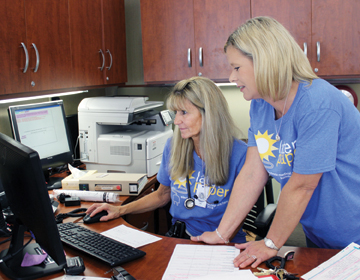
“It’s going to change everything.”
That, in short, is the impact Electronic Medical Records (EMR) will have at Village Shalom, according to Renée Schoonover, director of nursing. In fact, that change is already here.
The switchover from paper to electronic medical records for all current and future Village Shalom residents was fully implemented in late June. Now nurses’ stations and “med carts” throughout the campus are equipped with computers instead of paper forms for documentation of everything from residents’ medication doses to their activity preferences. Nursing Department staff members have spent many months in training to become proficient in the new technology.
It has taken nearly two years for Village Shalom to navigate the complex process of bringing the organization’s medical recordkeeping into the computer age. Driven primarily by the Information Technology and Nursing departments, and drawing on the input and problem-solving skills of virtually every other department as well, Village Shalom’s conversion to EMR has truly been a team achievement in technology, training and logistics.
“It’s all encompassing,” explained Lora Baugher, director of information technology. “It involves residents’ admission files, care plans, ID notes (interdisciplinary information on residents’ activities, preferences, dietary needs, etc.) and assessments. It has been a real learning process for all of us.”
While some elements of the shift to EMR have been up and running for as long as six months, the final piece of the multi-part process — all-electronic physicians’ medication orders and charting — went “live” on June 25. It represents a major change for Village Shalom and a new era in the way health records will be maintained in senior-living and long-term care organizations. While Village Shalom is not the first retirement community to adopt EMR, it is still ahead of the curve.
Unlike physicians, hospitals and other acute-care providers that are federally mandated to adopt EMR by late 2014 (or face financial penalties beginning in 2015), there is no such requirement for long-term-care or senior-living facilities — at least, not yet. However, senior-living communities like Village Shalom that choose to make the leap to EMR anticipate reaping a number of benefits.
“For one, the admissions process will be faster,” said Schoonover. “We can input a resident’s medications by checking them off on an electronic checklist instead of hand writing each medication’s name and dosage.”
Other advantages include eliminating a duplication of records and forms in various departments, as all information can now be shared across departments in a single electronic document. The handling and storage of mountains of paper forms, files and notes will also be vastly reduced.
As other health-care providers adopt EMR as well, Village Shalom’s ability to share crucial medical information with doctors, hospitals and pharmacies will be streamlined. And quite simply, electronic medical records are easier to read. Gone is the challenge of trying to decipher someone else’s handwriting.
The transition, though, has presented some challenges of its own. “Staff members have different comfort levels with their ability to do this,” Schoonover commented, noting that old habits are hard to break. “Some of the longer-term staff who are used to using paper are concerned that the information they input can disappear — poof — or that they’ll hit the wrong button and lose everything.”
Such worries are unfounded, Baugher reassured. “You always have to have a Plan B. We have a backup plan that downloads a copy of the medical record to a location off the network, attached to our generator and UPS (uninterrupted power source), so even if all the power goes out across the campus, we can still print the medical record. We have a number of backup systems in place.”
Readying all systems and staff for EMR implementation has involved much behind-the-scenes work on many fronts, Baugher explained. “It has involved getting the network, computers, AOD (Answers On Demand — Village Shalom’s organization-wide, multi-functional database) and additional modules ready. We’ve planned training, trained a core group of nurses who have then trained the rest of the staff, and put together reference guides for all their desks. For the last couple of years, it’s just been a part of life.” This was, of course, in addition to everyone’s regular job responsibilities.
“The people from AOD had a huge part in it,” said Schoonover. “They led us through the process. They do this all the time.”
Baugher and Schoonover commended Village Shalom staff members who also have helped to smooth the way for EMR. “Jacinda Farmer in medical records and Duke Ondieki, house supervisor, know the staff and the system, and have done a lot of the training. Kendra Kelso, staff scheduler, has had to reschedule nursing staff to fill in where nurses are pulled into training sessions,” Baugher said.
“The nurses have been well trained,” she noted, “but we will have extra support on the floor to alleviate any staff anxiety” while EMR gets up to full speed.
What difference will Village Shalom’s residents notice? Probably very little, agreed Schoonover and Baugher. “Except,” noted Baugher, “the nursing staff will have more time to spend with residents instead of doing paperwork.”
Linda Salvay is communications manager at Village Shalom.